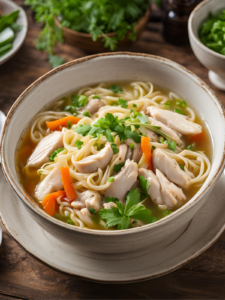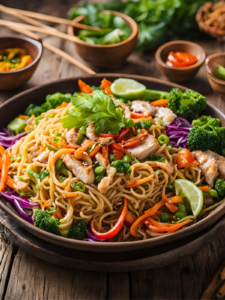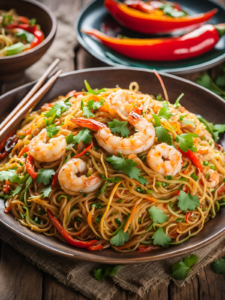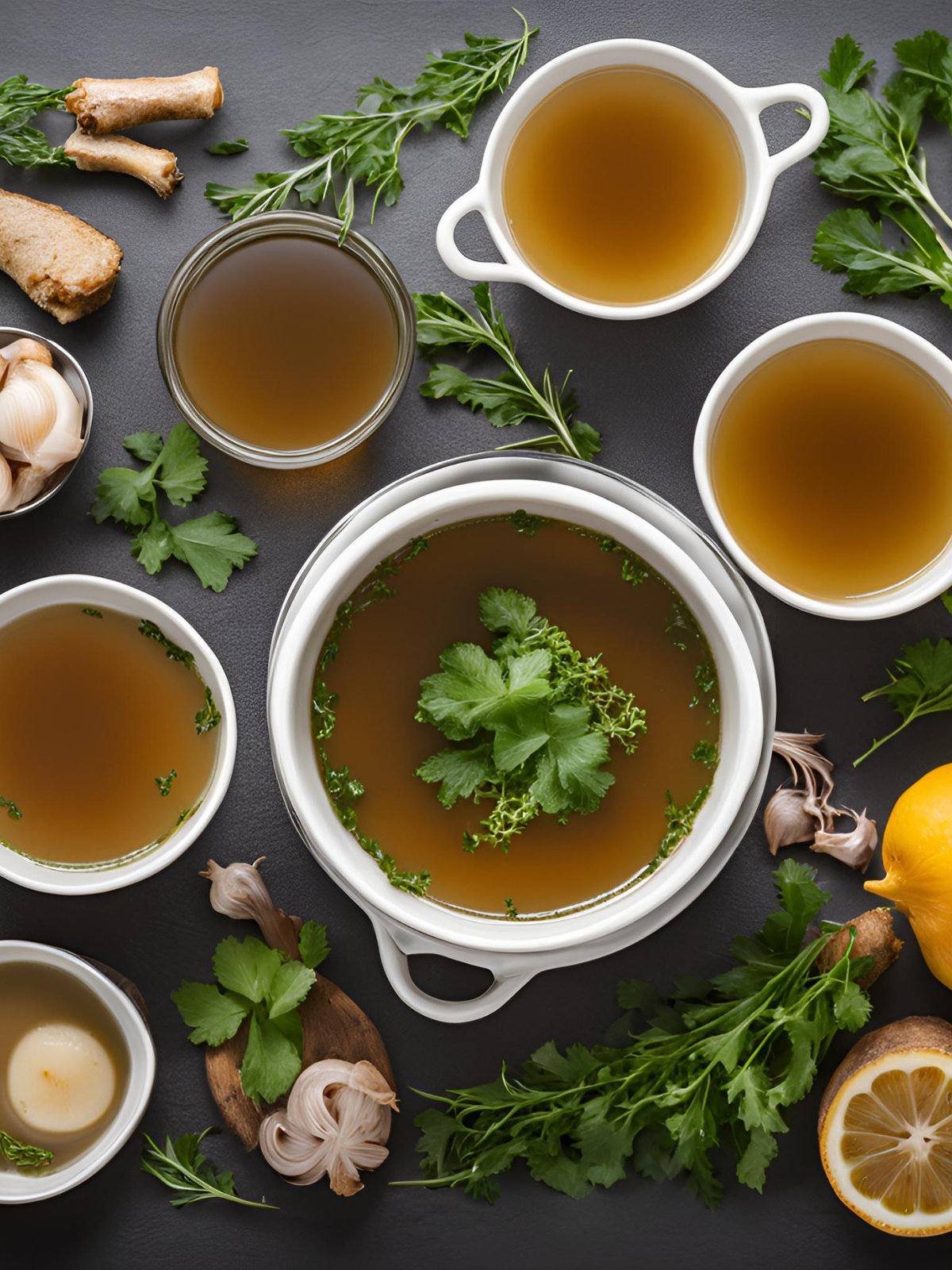Bahmi, a versatile noodle dish popular in Southeast Asia, is more than just food—it’s a flavorful representation of culture and tradition. Originating from Chinese influences, bahmi has been embraced and transformed by countries like Indonesia, Malaysia, and Singapore into dishes that reflect local ingredients and cooking styles.
In this article, we’ll explore five famous types of bahmi, their unique characteristics, and why they’re loved by so many.
What is Bahmi?
The term bahmi originates from the Hokkien Chinese term for wheat noodles, bak-mi. Introduced to Southeast Asia by Chinese immigrants, bahmi has been adapted to local tastes, resulting in dishes that are unique to each region.
Typically made from wheat flour and eggs, bahmi noodles are known for their springy texture and versatility, making them a staple in countless recipes ranging from soups to stir-fries.
1. Mie Goreng (Fried Noodles)

Mie Goreng (Fried Noodles)
Mie Goreng, which translates to “fried noodles,” is a go-to dish in Indonesian and Malaysian cuisines. It’s a street food staple often served with a variety of toppings and sides.
What’s in Mie Goreng?
- Noodles: Typically made from wheat flour and eggs, giving them a springy texture.
- Sauce: Sweet soy sauce (kecap manis) is the star, providing a rich, caramelized flavor.
- Additions: Stir-fried with garlic, shallots, and chili for a flavorful kick. Proteins like shrimp, chicken, or tofu are commonly added, along with vegetables like cabbage and carrots.
Why It’s Special
Mie Goreng is loved for its balanced taste: sweet, salty, and slightly spicy. It’s quick to prepare, making it a popular choice for both home cooks and street vendors. A fried egg, crispy shallots, and a squeeze of lime often complete this dish, making it a feast for the senses.
2. Bakmi Ayam (Chicken Noodles)

Bakmi Ayam (Chicken Noodles)
Bakmi Ayam is a comforting noodle dish originating from Indonesia, known for its simple yet flavorful ingredients. It’s often served in two parts: noodles topped with seasoned chicken and a side of clear soup.
What Makes Bakmi Ayam Unique?
- Noodles: Thin, egg-based noodles with a soft texture.
- Chicken Topping: The chicken is usually soy-braised, seasoned with garlic, and spiced with white pepper.
- Broth: A light, aromatic chicken or vegetable broth accompanies the noodles.
Cultural Importance
Bakmi Ayam is often enjoyed for breakfast or lunch. Its wholesome and hearty qualities make it a dish that feels like home. Sambal (chili paste) and pickled cucumbers are common accompaniments, adding a burst of flavor.
3. Mie Kuah (Noodle Soup)

Mie Kuah (Noodle Soup)
When it comes to comfort food, Mie Kuah, or noodle soup, is a top choice. This dish can range from a clear, simple broth to a richly spiced, coconut-based soup, depending on regional variations.
Two Popular Types of Mie Kuah
- Mie Soto: Noodles served in a vibrant yellow broth flavored with turmeric, lemongrass, and lime. Topped with shredded chicken, boiled eggs, and bean sprouts, it’s hearty and satisfying.
- Mie Udang: A seafood twist on noodle soup, made with shrimp and a rich, savory broth that showcases the freshness of the sea.
Why People Love Mie Kuah
It’s perfect for cold days or when you’re in need of something warm and nourishing. The flexibility of toppings—from fried shallots to lime wedges—lets you customize each bowl to your liking.
4. Mie Goreng Jawa (Javanese Fried Noodles)

Mie Goreng Jawa (Javanese Fried Noodles)
A Javanese take on fried noodles, Mie Goreng Jawa is known for its sweeter and spicier profile compared to traditional Mie Goreng. It incorporates unique Javanese spices, giving it a distinct taste.
Ingredients That Make It Stand Out
- Spice Paste: A blend of candlenuts, garlic, and coriander forms the base flavor.
- Noodles: Hand-pulled egg noodles are preferred for their chewy texture.
- Vegetables: Mustard greens, tomatoes, and cabbage add freshness to the dish.
Cooking Technique
Mie Goreng Jawa is often cooked over a charcoal fire, giving it a smoky aroma that elevates its taste. Topped with a fried egg and served with spicy sambal, this dish is a favorite in Javanese food stalls.
5. Bahmi Goreng Singapura (Singapore Fried Noodles)

Bahmi Goreng Singapura (Singapore Fried Noodles)
A fusion favorite, Bahmi Goreng Singapura combines the culinary influences of Chinese, Indian, and Malay cuisines. Unlike other fried noodles, it’s characterized by its bold use of curry spices.
What’s in Bahmi Goreng Singapura?
- Noodles: Thin vermicelli noodles, which soak up the flavorful spices.
- Seasoning: Curry powder is the defining ingredient, giving the dish its vibrant color and taste.
- Toppings: Common additions include prawns, char siu (Chinese BBQ pork), eggs, and mixed vegetables.
Why It’s a Must-Try
This dish is a staple at Singaporean hawker centers, offering a quick yet flavorful meal. Its spicy and aromatic profile appeals to those who love bold flavors.
Tips for Making Bahmi at Home
Cooking bahmi dishes at home is simple and rewarding. Here’s how you can make it taste authentic:
- Use Fresh Ingredients: Fresh vegetables, herbs, and proteins enhance the dish’s flavor.
- Balance the Seasoning: Southeast Asian cuisine is all about harmony—combine sweet, salty, spicy, and tangy flavors.
- High Heat Cooking: For stir-fried bahmi, cook quickly on high heat to achieve the smoky, slightly charred flavor.
- Customize Toppings: From sambal to fried shallots, adding unique toppings lets you create your perfect dish.
Conclusion
Bahmi is more than just noodles—it’s a celebration of flavors and traditions. Whether you’re savoring the sweet and spicy Mie Goreng or the comforting warmth of Mie Kuah, there’s a type of bahmi for every occasion. Each dish carries its own story, inviting you to explore the rich culinary heritage of Southeast Asia, one bite at a time.












Leave a Reply